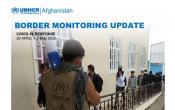Afghanistan
Operation: Afghanistan
Location
{"longitude":65,"latitude":34,"zoom_level":0,"iso_codes":"'AFG'"}
By clicking on the icons on the map, additional information is displayed.
The boundaries and names shown and the designations used on this map do not imply official endorsement or acceptance by the United Nations.
Key Figures
| 2020 planning figures | |
| 60,000 | internally displaced Afghan households will receive core relief items |
| 500 | refugees and asylum-seekers with specific needs will receive sectoral cash grants |
| 60 | educational facilities will be constructed or improved |
| 2018 year-end results | |
| 15,700 | Afghan refugee returnees received cash grants to help address their immediate needs |
| 13,000 | IDP households received core relief items and 7,300 households received hygienic supplies |
| 64% | of 15-24 year old refugee returnees were enrolled in certified livelihood trainings |
| 61 | community-based projects were implemented across the country, in an effort to increase absorption capacity and facilitate returns and reintegration |
Latest Updates
Updates and additional information are available on UNHCR's Inter-Agency Information Sharing Portal.
People of Concern
12%
Increase in
2019
2019
| 2019 | 3,081,364 |
| 2018 | 2,759,010 |
| 2017 | 2,454,451 |

[["Refugees",72228],["Asylum-seekers",251],["IDPs",2553390],["Returned refugees",8402],["Others of concern",447093]]
Loading ...
Afghanistan
< Back
2019
{"categories":[2015,2016,2017,2018,2019,2020],"budget":[150.64388639,259.233864759,137.626888924,125.83413416,121.7056801,123.20575754],"expenditure":[70.35477096,197.82190746,70.00669813,62.0598531,60.63418638,null]}
{"categories":[2015,2016,2017,2018,2019,2020],"p1":[66.83857405,187.89448891,79.923683844,35.9332016,29.17698365,23.03982739],"p2":[null,null,null,null,null,null],"p3":[56.92509855,42.006523619,39.77442109,60.2439613,71.18420028,73.30159683],"p4":[26.88021379,29.33285223,17.92878399,29.65697126,21.34449617,26.86433332]}
{"categories":[2015,2016,2017,2018,2019,2020],"p1":[42.22418797,174.62465414,42.60149276,16.78422529,11.99405259,null],"p2":[null,null,null,null,null,null],"p3":[17.78314669,12.48364936,10.39492624,23.78516525,30.24308225,null],"p4":[10.3474363,10.71360396,17.01027913,21.49046256,18.39705154,null]}
Loading ...
CHOOSE A YEAR
- 2014
- 2015
- 2016
- 2017
- 2018
- 2019
- 2020
Year-end Overview
Operational Environment
While Afghanistan is entering the 40th year of protracted displacement, UNHCR expects the humanitarian situation to remain complex, despite the encouraging efforts in peace negotiations and the strong political will in Afghanistan. Persistent socio-economic challenges compound protection risks and limit returnee reintegration prospects, which often results in negative coping mechanisms, such as child labour, early marriage, labour exploitation and debt.Under the Solutions Strategy for Afghan Refugees (SSAR) framework, the Government of Afghanistan will continue progress on development and sustainable reintegration through the implementation of the Displacement and Return Executive Committee (DiREC) policy framework and Action Plan, while challenges will likely persist in fully translating policy into implementation at the field level.
In July 2018, the Government of Afghanistan officially announced its decision to join and support the Comprehensive Refugee Response Framework (CRRF) as a country of origin. Going forward, UNHCR and partners will work closely with the Government of Afghanistan to develop a roadmap and decide upon the way forward in rolling out comprehensive responses in this specific context.
The planned Parliamentary and Presidential elections in Afghanistan during October 2018 and early 2019, respectively, may result in demonstrations and targeted attacks on election related premises, thus impacting UNHCR’s operations.
The Ministerial Conference on Afghanistan that will take place in Geneva in November 2018, co-hosted by Afghanistan and the United Nations, will demonstrate progress made towards benchmarks set at the 2016 Brussels Conference and should also reinvigorate donor support for continued resources and engagement.
In 2019, UNHCR’s planning assumptions are based on the expected returns of some 60,000 refugees to Afghanistan. However, returns may increase or decrease depending on the protection environment in Afghanistan and in the region.
Highly complex scenarios of internal displacement, marred by insecurity and shrinking humanitarian space are expected to continue in 2019. Drought will create protection risks for IDPs, increasing their vulnerability and reliance on negative coping mechanisms.
Key Priorities
In 2018, UNHCR will focus on:- Supporting voluntary repatriation to Afghanistan. Upon return to Afghanistan, each Afghan refugee returnee is given USD 200 in one of the four encashment centers in Herat, Jalalabad, Kabul or Kandahar. This cash grant will cover transportation costs from the country of asylum to the place of origin and will partially assist returnees in managing their immediate humanitarian needs upon return. Cross-border referrals, enhance protection monitoring through UNHCR filed visits, and inter-agency joint assessments will enable the identification of people with specific needs and facilitate a timely response and referral within established network of service providers.
- Informed by protection monitoring, with limited resources, UNHCR will continue to exercise its responsibilities as the Protection Cluster lead, coordinating protection activities in humanitarian settings, and as Emergency Shelter Cluster lead in conflict situations, coordinating and directly intervening in the delivery of in-kind relief items or cash-based humanitarian assistance to conflict-induced IDPs.
- Scaling down its interventions for displaced families from Pakistan’s North Waziristan Agency and responsibly hand over the management of response to the Government of Afghanistan.























